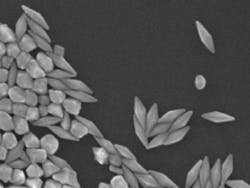Label-free technique senses movement of single molecules over hours
Houston, TX--Scientists can detect the movements of single molecules by using fluorescent tags or by pulling them in delicate force measurements, but only for a few minutes. A new plasmonic technique developed by Rice University researchers will allow them to track single molecules without modifying them—and it works over longer timescales.
A team led by Jason Hafner, an associate professor of physics and astronomy and of chemistry, has shown that the plasmonic properties of nanoparticles can "light up" molecular interactions at the single-molecule limit.1
Localized surface-plasmon resonance
Hafner's method takes advantage of the ability of metal nanoparticles to focus light down to biomolecular scales through localized surface-plasmon resonance (LSPR). The gold nanoparticles ultimately used in the experiment scatter light in visible wavelengths, which can be detected and spectrally analyzed in a microscope.
"The exact peak wavelength of the resonance is highly sensitive to small perturbations in the nearby dielectric environment," said graduate student Kathryn Mayer, the lead student on the experiment. "By tracking the peak with a spectrometer, we can detect molecular interactions near the surface of the nanoparticles."
Hafner first discussed their progress at a 2006 conference after a presentation on gold nanostars his lab had developed. "We had extremely preliminary data, and I said, 'Maybe we've got it.' I thought we were close," he recalled.
Bipyramids
What took time was finding the right particle. "We started with nanorods, which don't scatter light well, at least not the small nanorods we produce in my lab. Then we tried nanostars and found they were very bright and sensitive, but each was a different shape and had a different peak wavelength."
The team settled on bipyramids—140-nm-long, 10-sided gold particles that focus light at their tips, creating a halo-like "sensing volume," or the dielectric environment in which changes can be read by a spectrometer.
Hafner and his colleagues borrowed bioconjugate chemistry techniques, coating the bipyramids with antibodies and then adding antigens that strongly bind to them. Then the antigens were rinsed off. Whenever one was released from its bond to the bipyramid antibody, the researchers detected a slight shift toward the blue in the red light naturally scattered by gold bipyramids.
10-hour tracking possible
The process is "label-free," meaning the molecule itself is being detected, rather than a fluorescent tag that requires modification of the molecule, Hafner said. Also, the dielectric property being detected is permanent, so molecules could be tracked for more than 10 hours, as compared with only minutes with current methods.
"The ability to measure over long time scales opens the possibility to study systems with strong affinity at the single-molecule limit, such as lectin-carbohydrate interactions responsible for cell recognition and adhesion," Hafner said. "Other single-molecule methods based on fluorescence are limited by photobleaching, and those based on force measurements are limited by radiation damage and mechanical instabilities."
Work needs to be done before LSPR becomes an ideal biological sensor, he said. The team plans to tweak the bipyramids and will test other particles. "With this bipyramid, we went a little too red," he said. "It's a compromise. Make them long and they're really sensitive, but so red that we don't get much signal. Make them shorter, they're somewhat less sensitive but you have more signal. If we can get the signal-to-noise ratio up by a factor of two or three, we think it will be a powerful method for biological research."
The team
In addition to Mayer, Hafner's co-authors included Peter Nordlander, a Rice professor of physics and astronomy and of electrical and computer engineering, former Rice graduate student Feng Hao, now a postdoctoral fellow at Sandia National Laboratories, and Rice graduate student Seunghyun Lee.
Funding for the project came from the National Science Foundation's Integrative Graduate Research and Educational Training program and Nanoscale Science and Engineering Initiative, the U.S. Army Research Office and the Welch Foundation.
REFERENCE:
1. Kathryn M. Mayer et al., 2010 Nanotechnology 21 255503; doi: 10.1088/0957-4484/21/25/255503.
About the Author
John Wallace
Senior Technical Editor (1998-2022)
John Wallace was with Laser Focus World for nearly 25 years, retiring in late June 2022. He obtained a bachelor's degree in mechanical engineering and physics at Rutgers University and a master's in optical engineering at the University of Rochester. Before becoming an editor, John worked as an engineer at RCA, Exxon, Eastman Kodak, and GCA Corporation.

